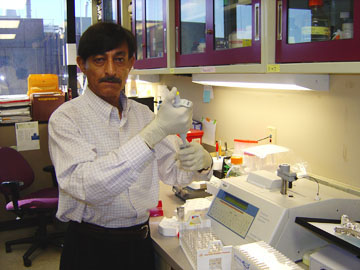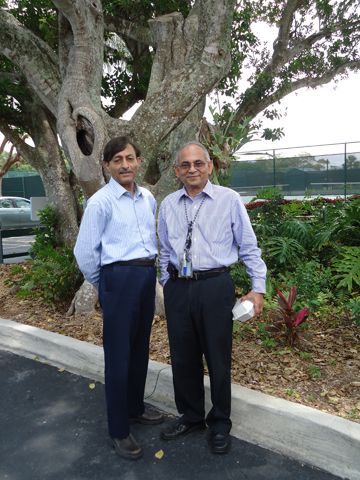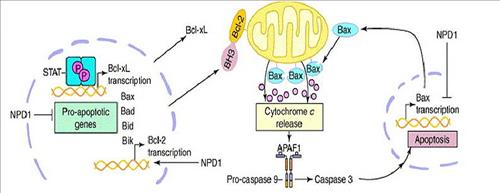
Pranab Mukherjee, M.S., Ph.D.

Pranab Mukherjee, M.S., Ph.D.
Associate Professor of Research, Neuroscience and Ophthalmology
Associate Professor of Research, Neuroscience and Ophthalmology
Neuroscience Center of Excellence email: pmukhe@lsuhsc.edu
Web Page
School of Medicine, LSU Health
2020 Gravier Street, Suite D
New Orleans, LA 70112
New Orleans, LA 70112
Phone: (504) 599-0895
Fax: (504) 568-5801
http://www.medschool.lsuhsc.edu/faculty/docs/
Pranab 2009 Faculty Web site update.pdf

Dr. Pranab Mukherjee and Dr. Nara Ray
at the 2012 ARVO Conference
Degrees
1974: Ph.D., University of Calcutta, India
1969: M.S., University of Calcutta, India
1967: B.S., University of Calcutta, India
Bio
2008-present: Associate Professor-Research, Ophthalmology & Neuroscience, Neuroscience Center of Excellence, LSU Health Sciences Center, New Orleans, LA.
2002-2007: Assistant Professor-Research, Ophthalmology & Neuroscience, Neuroscience Center of Excellence, LSU Health Sciences Center, New Orleans, LA.
1992-2002: Instructor, Ophthalmology & Neuroscience, Neuroscience Center of Excellence, LSU Health Sciences Center, New Orleans, LA.
1987-1992: Staff Scientist, Oschner Medical Foundation, New Orleans, LA.
1979-1987: Resident Associate, Waksman Ins. of Microbiology, Piscataway, NJ.
1975-1979: Resident Fellow, Biological Chemistry, Harvard Medical School, Boston, Mass.
1974-1975: Postdoctoral Fellow, Atomic Energy, University of Calcutta, India.
Patents
United States Patent Application Serial No. 10/911,835 and PCT/US04/25636, filed Aug. 2004. Inventors: Nicolas G. Bazan, Charles N. Serhan, Pranab K. Mukherjee, Karsten Gronert. Assignee: LSUHSC. “Neuroprotectin D1 protects against cellular apoptosis, and retinal diseases.”
Awards and Honors
January 8-10, 2007: International Conference on Frontier Researches in Integrative Physiology (ICFRIP)-2007, University of Calcutta, Calcutta, India
January 15-18, 2009: Invited Plenary Speaker and Chairman ASIA - ARVO-International Meeting on Research in Vision and Ophthalmology. Hydrabad International Convention Center, Hydrabad, India.
Clinical Interests
Currently my interest has been focused on the study of proteomics profiling of the various class of proteins, such as pro- and anti- apoptotic, pro- and anti-inflammatory proteins, metabolic pathways, and glycolytic pathway proteins, altered by NPD1 under oxidative stress in the RPE. We will use immunobloting of 2D gel analysis of RPE cell extracts treated with NPD1 under oxidative stress. The results of this 2D analysis will provide us with ways to run Western blot and to further confirm the NPD1 modified proteins under experimental conditions.

Research Interests
The main focus of my research is to study cell signaling pathways. An in vitro model using retinal pigment epithelial cells (ARPE-19) has been developed to study the oxidative stress initiated by H2O2 and TNF-ά, induced gene expression, apoptotic cell death and neuroprotection. Since most neurodegenerative diseases are associated with neuronal loss, the identification of a potent neuroprotective agent could shed light on the treatment of some eye diseases such as glaucoma and age-related macular degeneration (AMD). To this end, we reported the development of neuroprotectin D1 (NPD1), a docosahexanoic acid-derived docosatriene that protects ARPE-19 cells from oxidative stress. We found that NPD1 also up-regulates the anti-apoptotic proteins Bcl2 and Bcl-xl, decreases pro-apoptotic Bax and Bad expression and caspase-3 activation, and inhibits IL-1-induced COX-2 expression under oxidative stress in the retinal pigment epithelium (RPE). Neurotrophins, particularly pigment epithelium-derived factor (PEDF), induce NPD1 synthesis and its polarized apical secretion, implying paracrine and autocrine bioactivity of this lipid mediator. DHA and PEDF also synergistically activate NPD1 synthesis and anti-apoptotic protein expression and decreased pro-apoptotic Bcl2 protein expression during oxidative stress.
Selected Publications
Calandria, J.M., Asatryan, A., Balaszczuk, V., Knott, E.J., Jun, B.K., Mukherjee, P.K., Belayev, L., and Bazan, N.G. NPD1-Mediated Steroselective Regulation of BIRC3 Expression Through cREL is Decisive for Neural Cell Survival, 2015, Cell Death and Differentation, 1-15.
Marcheselli, V.L., Mukherjee, P.K., Arita, M., Hong, S., Antony, R., Sheets, K., Winkler, J.W., Petasis, N.A., Serhan, C.N., Bazan, N.G: Neuroprotectin D1/protectin D1 stereoselective and specific binding with human retinal pigment epithelial cells and neutrophils, Prostaglandins, Leukotrienes and Essential Fatty Acids (2010) 82:27–34.
Vaccarino, A.L., Paul, Dennis, Mukherjee, P.K., Rodriguez de Turco, E.B., Marcheselli, V.L., Xu,L., Trudell, M.L., Minguez, J.M. , Matia, M.P., Sunkel, C., Alvarez-Builla, J., Bazan, N.G: Synthesis and in vivo evaluation of non-hepatotoxic acetaminophen analogs,Bioorganic & Medicinal Chemistry (2007) 15:2206-2215.
Mukherjee, P.K., Marcheselli, V.L., de Rivero Vaccari, J.C., Gordon, W.C., Jackson,F., Bazan, N.G: Photoreceptor outer segment phagocytosis selectively attenuates oxidative stress induced apoptosis with concomitant neuroprotectin D1 synthesis, Proc. Natl. Acad. Sci. (2007) 104:13158-13163.
Mukherjee, P.K., Chawla, A., Loayza, M.S., Bazan, N.G: Docosanoids are Multifunctional Regulators of Neural Cell Integrity and Fate: Significance in Aging and Disease, Prostaglandins Leukot. Essent. Fatty Acids(2007) 77:233-238.
Mukherjee, P.K., Marcheselli, V.L., Barreiro, S., Hu, J., Bok, D., Bazan, N.G: Neurotrophins enhance retinal pigment epithelial cell survival through neuroprotectin D1 signaling, Proc. Natl. Acad. Sci. (2007) 104:13152-13157.
Lukiw, W.J., Mukherjee, P.K., Cui, J.G., Bazan, N.G: A2E selectively induces cox-2 in ARPE-19 and human neural cells, Curr. Eye Res. (2006) 31:259-263.

 myLSUHSC
myLSUHSC